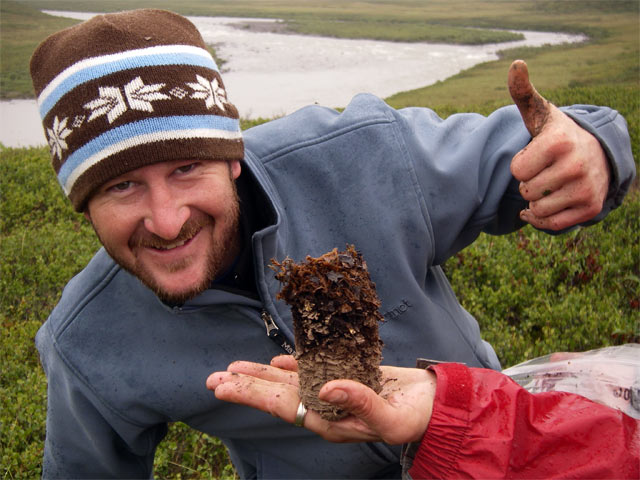( Log In ) Log In is for TREC Teachers & Researchers only
  |
| Charla_Jordan |
 Jul 25 2006, 03:16 PM Jul 25 2006, 03:16 PM
Post
#1
|
 Advanced Member    Group: TREC Team Posts: 36 Joined: 12-April 06 Member No.: 28 |
July 22, 2006 – Soil Sampling
Temperature 38, raining Today we headed out to the Sag River. Laura is involved in an experiment that is conducting cross-site comparison of percents of carbon and nitrogen in the soil. This soil sampling will be conducted in many places in the United States using the exact same sampling methods and the same lab to process the samples. We will sample from the Sag River toposequence, which is a marked plot that was established in 1984. This area is less acidic than the surrounding areas because of the adjacent river. When we arrived half of the group started doing percentage coverage counts, while the other half started drilling for soil samples.  Brian and Amie collect the needed soil samples. Notice the Sag River in the back ground. Collecting these samples can be very difficult at this site because the ground is so moist, the samples do not what to come up out of the ground. After several tries, you can finally get a good sample.  One down, thirty more to go! See the layers in the sample--top is organic material and bottom is mineral clay. As we were sampling, we ran across this fuzzy caterpillar. He looked very cold, so we put him back in the tussock (grass).  Can you see him shivering? As we were walking back to the vehicles, I spotted some animal dropping. Carol told me that it was Caribou poo. We were standing in the middle of a blueberry field. Caribou and bears love blueberries. It was time to go.  Caribou Poo The real work began back at the lab. All of the thirty soil samples had to be prepared for shipping. First, all of the living material (plants, mosses, and fungi) had to be removed. This is slow and tedious work.  Beginning the slow process of removing all of the plant materials. From left to right Jef, Carol, Brian, and David  This is a lot of plant material removed from the sample. After all of the plant materials have been removed, the soil is placed back in a baggy and left to dry before being shipped to the lab for analysis. Toolik camp believes in the phrase “all work and no play”. When I left Lab 2 tonight, I spotted an unusual site—an wooden robot. At Toolik the only thing there is to burn is pallets that supplies get shipped in on. So, for fun the camp made a wooden robot to burn. I missed the official “Lighting of the Robot”, but did have time to sit by the fire for awhile.  Who said scientist don’t know how to have fun. So ends my second wonderful day at Toolik. ***Answer to yesterday’s question: What is Permafrost? Permafrost is soil that stays in a frozen state for more than two years in a row. Most permafrost is located in high latitudes (like Alaska). Plant life can be supported only within the active layer (top part) because growth can occur only in soil that is fully thawed for some part of the year. Permafrost in Prudhoe Bay, Alaska, is up to 1970 feet thick during the winter. |
  |
1 User(s) are reading this topic (1 Guests and 0 Anonymous Users)
0 Members:

|
NSF Acknowledgment & Disclaimer | Time is now: 9th November 2024 - 04:43 PM |
Invision Power Board
v2.1.7 © 2024 IPS, Inc.








